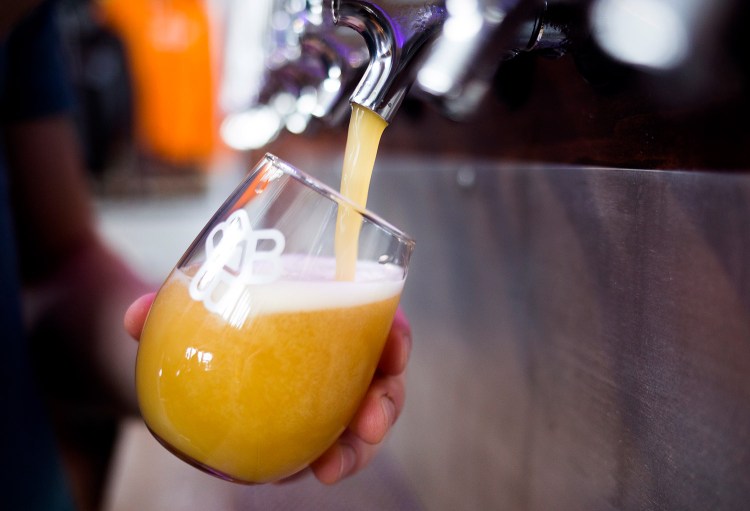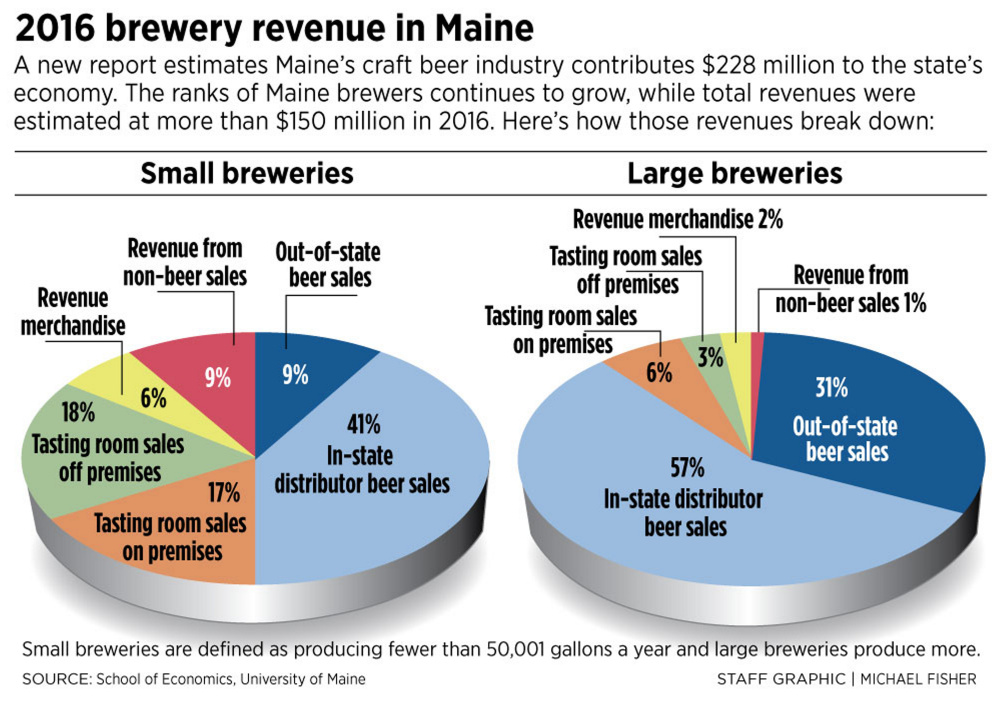Brewing is on a tear in Maine, with 16 new breweries added in 2016 and production forecast to grow by 41 percent in the next three years.
The growth isn’t confined to the Portland area, a mecca for beer lovers. Piscataquis is now the only Maine county that doesn’t have a brewery, and the industry is heating up in areas like Penobscot County, where 11 breweries opened in the last decade, according to a report from the Maine Brewer’s Guild and the University of Maine School of Economics that was released Monday.
“If you consider the number of breweries in the state, it might seem like the growth is unsustainable, but not all these breweries are trying to be large-scale,” said Sean Sullivan, executive director of the guild. “Some want to sell their beer super-locally, and more and more people are realizing there is a local product that tastes better, is produced in their community, and they are making the switch.”
Maine breweries added a total of $228 million to Maine’s economy last year, and employed more than 1,600 workers, according to estimates based on survey responses from guild members. The estimated total revenue of Maine brewers was more than $150 million in 2016, a 17 percent increase from 2013, according to the report.
The growth of breweries in Maine outpaced the growth rate of breweries nationwide five out of the last six years. Before 2007, there were 14 breweries in the guild. Now there are 82. The guild website says there were 93 breweries in the state as of Jan. 10, noting that numerous brewers hold multiple licenses. And Sullivan said he knows of at least three breweries opening soon.
“I wasn’t expecting to see the level of economic impact we found,” said Andrew Crawley, a University of Maine economist who co-authored the report. “If it continues at this pace, it will start to overtake some more established industries. We are going to see craft brewing right up there as a major part of the state’s industrial make-up.”
The growth of craft breweries is already being felt in tourism circles. According to state tourism analysts, 35 percent of tourists in 2015 stopped by a local brew pub or craft brewery, according to a survey in the latest annual report from the Maine Office of Tourism. Another survey in the report estimated that 18 million people visited the state in 2015, meaning roughly 6.3 million of them made a stop at a brewpub or craft brewery.
Crawley said a big surprise for him was the geographic reach of craft breweries, which employed 1,632 full- and part-time workers who were paid a total of $50.4 million in 2016. The average yearly pay of a brewery employee is $34,726.
“The north and central Maine is where people are talking about significant expansions, and that is a positive economic sign of the industry growing across the state,” Crawley said. The impact is especially noticeable in places that have dealt with significant economic hardships.
“It is really good to see the impact it is having in places where there have been declines,” he said.
The average small brewery employs six people, while the average large brewery employs 61 workers, the report said. The report defines a small brewery as one that produces fewer than 50,001 gallons of beer a year.
Penobscot County is expected to see the highest increase in production, 92 percent, followed by Cumberland, York, Waldo and Hancock counties.
LARGE VERSUS SMALL
Although the report’s authors said they expect to see sustained growth in craft beer, there have been signs that the market could be becoming saturated in Portland, the industry’s epicenter. Geary’s, the first of Maine’s craft breweries, saw its production drop by a third from 2011 to 2015 as customers wandered to other brands. On the verge of bankruptcy, it is being sold to new owners.
Bart Watson, chief economist at the National Brewers Association, said established brewers across the country are losing market share as consumers gravitate to new breweries.
“They’re facing a lot more competition, with over 5,000 breweries now in the United States, but also those regional breweries are being pursued by the large brewers and being bought out. It’s a very competitive market now,” Watson said.
Maine brewers produced almost 300,000 barrels of beer last year, a 25 percent increase from 2013. More than three-quarters of guild members are small breweries that produce 520 barrels a year on average. They distribute 96 percent of their beer inside Maine, while large breweries distribute 27 percent of their product outside of the state.
Two of those large breweries – Shipyard and Allagash – are among the top 50 U.S. craft brewing companies, the Brewers Association said. A number of breweries have expanded production in recent years to keep up with demand for their products. Brewery tap rooms, where customers can buy beer and drink samples, have proliferated since they were allowed under a 2011 state law.
Sullivan, from the Maine Brewers Guild, said tap rooms are just the tip of the iceberg. Approximately 40 percent of breweries already serve food, and others host live music, bar game tournaments and other events to draw customers. Some are experimenting with lodging and other ways to become destination breweries and attract visitors, Sullivan said. In other cases, brewers want to introduce members of their community to craft beer and develop a local market for their product.
The production from small breweries is forecast to grow 61 percent by 2020, compared with 16 percent growth by large breweries.
“What I don’t think we will see is an enormous number of Maine breweries grow to large-scale in the near future,” Sullivan said. “Growth looks different depending on who you speak to.
“These destination breweries will increase as a part of what is making the whole industry grow and tick.”
Peter McGuire can be contacted at 791-6325 or at:
Send questions/comments to the editors.




